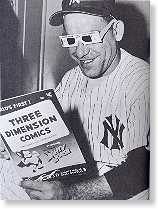The Business Prevention Department
 The "Yeah, But's" Of The Corporate Bureaucracy
The "Yeah, But's" Of The Corporate Bureaucracy
By David Miranda
You won't find it on any organizational chart, but it's there - the business prevention department.
It's prime objective is to champion attitudes that discourage the new and the innovative within the organization. They are "you can't get there from here" people. Chances are you have attended meetings with some members of this department. They are easily identified. They are most likely your boss or boss' boss or members of your peer group. They are the ones shaking their heads on your new idea after just seeing only the title slide. They normally begin their comments with "Yeah, but", as in, "Yeah, but, we tried that before"; or "Yeah, but, you don't understand".
The business preventionists come in all shapes and sizes, genders, ethnic groups, religious and political affiliation. They are good at what they do - resisting change.
Examples are many.
Take the IBM business preventionist who, after hearing a suggestion that "since we would be manufacturing millions of personal computers, we should also market our own operating system for it" replied, "Yeah, but, we don't do operating systems. We make computers. Let's get this guy, Gates, to do it."
Or how about the major television network executive who, after hearing a pitch for a 24 hour news channel replied "Yeah, but, who is going to watch news for 24 hours, Mr. Turner? I think this CNN idea is pie-in-the-sky."
Or the Barnes & Noble executive who, after hearing a pitch for selling books on the Internet said, "Yeah, but, I don't think you get it Mr. Bezos. People prefer to buy books in a real store. I am also not too crazy about the name, Amazon."
There's more. Newspapers could not see the threat of the likes of eBay and Craig's List. The music labels could not see the potential impact of Napster or the iPod. Microsoft missed the opportunity to be a Google, Yahoo!, MySpace, or YouTube. Blockbuster should have foreseen Netflix.
How about your organization? Is the business prevention department active? Here's a quiz:
- Are new ideas encouraged in your organization?
- Are they really? If so, what part of your marketing plan represents encouraging the new vs. reinforcing the status quo?
- Do new ideas come from the bottom up, top down, or as the result of competitor's initiatives?
- Is your company spending more time analyzing than doing?
- Does your company pride itself more in doing things right or doing the right things?
Defeat the "Yeah, but's".




 Busting Common Myths, Mistakes, and Misunderstandings On DIY Marketing
Busting Common Myths, Mistakes, and Misunderstandings On DIY Marketing



 Amateurs Spend Money On Marketing, Professionals Invest Money In Marketing
Amateurs Spend Money On Marketing, Professionals Invest Money In Marketing Your Brand Is Not A Commodity So Don't Act Like One In Media Buying
Your Brand Is Not A Commodity So Don't Act Like One In Media Buying
 Can Your Oldest Living Relative Understand What You're Pitching?
Can Your Oldest Living Relative Understand What You're Pitching?



 Understanding The Difference Is Critical In Marketing
Understanding The Difference Is Critical In Marketing



 Will The Web Have An Ad-Skipping, Ad-Zapping Technology?
Will The Web Have An Ad-Skipping, Ad-Zapping Technology?

 Remember People Buy Your Stuff, Not Marketing "Terms"
Remember People Buy Your Stuff, Not Marketing "Terms"
 The New Media Continuum - Extending The Brand Horizontally
The New Media Continuum - Extending The Brand Horizontally



